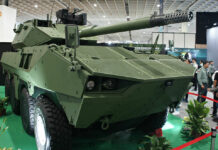Unconfirmed reports are claiming North Korea test fired two short-range missiles that eventually landed in the Sea of Japan on 15 March. South Korea’s Yonhap News Agency reported receiving a tip from an anonymous military officer announcing the missile test.
This unidentified source is quoted by Yonhap as saying the test missiles were short-range types launched “on a military-unit level, not at a national level.” It is not known if North Korea’s leader, Kim Jong-un, ordered the test launch.
The missiles are believed to be North Korea’s short-range KN-02 Toksa (Viper) missiles. The KN-02 is an upgraded variant of the Soviet-designed SS-21 Scarab A developed in the North by reverse-engineering a Syrian SS-21.
The KN-02 is a solid propellant missile fired from a mobile platform designed to give ground forces additional firepower on the battlefield. The missile is considered to be the most accurate in Pyongyang’s arsenal with an estimated range of between 120 and 140 kilometers. Preferred targets for this type of missile include airfields, bridges, command and control facilities, large buildings, troop assembly areas, and storage facilities.
Although the KN-02 is normally fitted with a fragmentation warhead, the standard warhead can be replaced with one capable of delivering a chemical, biological, or nuclear strike.
Pyongyang has engaged in a furious series of threats since the UN Security Council on 7 March adopted a comprehensive list of new sanctions to be applied against the North. The new UN sanctions were adopted in response to a prohibited nuclear test the North conducted on 12 February.
Kim Jong-un and other government officials in Pyongyang have unleashed an unceasing litany of war-like announcements since adoption of the new UN sanctions including threats of renewing hostilities with Seoul and promises to employ nuclear weapons capable of turning Washington, DC into a “sea of fire.”
News of this launch comes only one day after Kim Jong-un made a widely-publicized visit to an artillery unit on the Yellow Sea border with the South to observe a live-fire drill. South Korea and the United States are also currently engaged in annual training exercises, Foal Eagle and Key Resolve, which Pyongyang protests are aimed at destroying the North and constitute acts of war.
Many analysts believe Pyongyang has an arsenal of as many as 1,000 missiles. Most of these missiles are believed to have sufficient range to strike much of South Korea with some missiles capable of reaching key military facilities in Japan.
In a related development, US Secretary of Defense Chuck Hagel announced on 15 March that the United States would deploy an additional 14 ground-based anti-missile interceptors (GBIs) to Fort Greely in Alaska to augment the 26 interceptors now located at Fort Greely. Another four GBIs are currently in place at Vandenberg Air Force Base in California. Secretary Hagel also confirmed that the United States would proceed with the deployment of a second TPY-2 radar system to Japan to reinforce missile detection in the Pacific.



















